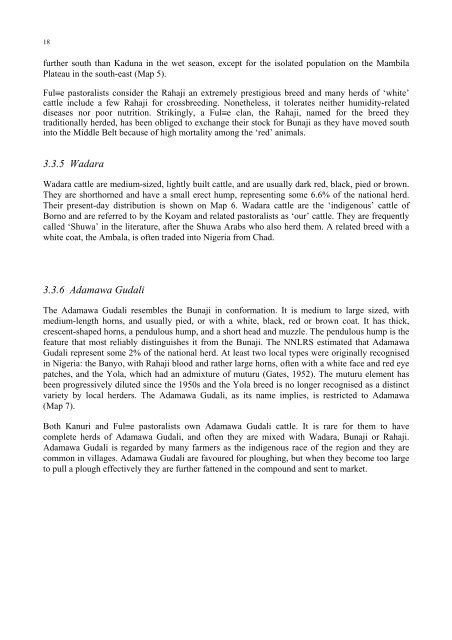ODI Livestock breeds WP.pdf - Roger Blench
ODI Livestock breeds WP.pdf - Roger Blench
ODI Livestock breeds WP.pdf - Roger Blench
Create successful ePaper yourself
Turn your PDF publications into a flip-book with our unique Google optimized e-Paper software.
18<br />
further south than Kaduna in the wet season, except for the isolated population on the Mambila<br />
Plateau in the south-east (Map 5).<br />
Ful≡e pastoralists consider the Rahaji an extremely prestigious breed and many herds of ‘white’<br />
cattle include a few Rahaji for crossbreeding. Nonetheless, it tolerates neither humidity-related<br />
diseases nor poor nutrition. Strikingly, a Ful≡e clan, the Rahaji, named for the breed they<br />
traditionally herded, has been obliged to exchange their stock for Bunaji as they have moved south<br />
into the Middle Belt because of high mortality among the ‘red’ animals.<br />
3.3.5 Wadara<br />
Wadara cattle are medium-sized, lightly built cattle, and are usually dark red, black, pied or brown.<br />
They are shorthorned and have a small erect hump, representing some 6.6% of the national herd.<br />
Their present-day distribution is shown on Map 6. Wadara cattle are the ‘indigenous’ cattle of<br />
Borno and are referred to by the Koyam and related pastoralists as ‘our’ cattle. They are frequently<br />
called ‘Shuwa’ in the literature, after the Shuwa Arabs who also herd them. A related breed with a<br />
white coat, the Ambala, is often traded into Nigeria from Chad.<br />
3.3.6 Adamawa Gudali<br />
The Adamawa Gudali resembles the Bunaji in conformation. It is medium to large sized, with<br />
medium-length horns, and usually pied, or with a white, black, red or brown coat. It has thick,<br />
crescent-shaped horns, a pendulous hump, and a short head and muzzle. The pendulous hump is the<br />
feature that most reliably distinguishes it from the Bunaji. The NNLRS estimated that Adamawa<br />
Gudali represent some 2% of the national herd. At least two local types were originally recognised<br />
in Nigeria: the Banyo, with Rahaji blood and rather large horns, often with a white face and red eye<br />
patches, and the Yola, which had an admixture of muturu (Gates, 1952). The muturu element has<br />
been progressively diluted since the 1950s and the Yola breed is no longer recognised as a distinct<br />
variety by local herders. The Adamawa Gudali, as its name implies, is restricted to Adamawa<br />
(Map 7).<br />
Both Kanuri and Ful≡e pastoralists own Adamawa Gudali cattle. It is rare for them to have<br />
complete herds of Adamawa Gudali, and often they are mixed with Wadara, Bunaji or Rahaji.<br />
Adamawa Gudali is regarded by many farmers as the indigenous race of the region and they are<br />
common in villages. Adamawa Gudali are favoured for ploughing, but when they become too large<br />
to pull a plough effectively they are further fattened in the compound and sent to market.

















